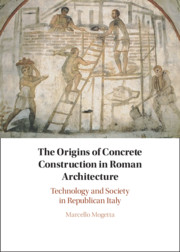 The Origins of Concrete Construction in Roman Architecture
The Origins of Concrete Construction in Roman Architecture Book contents
- The Origins of Concrete Construction in Roman Architecture
- The Origins of Concrete Construction in Roman Architecture
- Copyright page
- Contents
- Plates
- Figures
- Tables
- Acknowledgments
- One Introduction
- Two Deconstructing Roman Concrete
- Three A New Date for Concrete in Rome
- Four A View from the Suburbium
- Five Building Samnite Pompeii
- Six Colonial Networks
- Seven Conclusion
- Appendix Catalog of Sites
- Glossary
- Bibliography and Abbreviations
- Index
- Plate Section (PDF Only)
Four - A View from the Suburbium
Published online by Cambridge University Press: 15 June 2021
- The Origins of Concrete Construction in Roman Architecture
- The Origins of Concrete Construction in Roman Architecture
- Copyright page
- Contents
- Plates
- Figures
- Tables
- Acknowledgments
- One Introduction
- Two Deconstructing Roman Concrete
- Three A New Date for Concrete in Rome
- Four A View from the Suburbium
- Five Building Samnite Pompeii
- Six Colonial Networks
- Seven Conclusion
- Appendix Catalog of Sites
- Glossary
- Bibliography and Abbreviations
- Index
- Plate Section (PDF Only)
Summary
The chapter expands the analysis by comparing and contrasting urban and rural patterns across different environmental zones of the Roman Campagna, focusing specifically on the role of villa architecture. Whereas in the tuff region closer to Rome concrete construction lagged behind the early phase of the technique in the metropolis, the limestone architecture in the territory of neighboring Tibur shows a more complex pattern, reflecting how the diffusion of monumental rural residence in areas with easier access to both key ingredients for high-quality mortars, volcanic ash and lime, could have triggered technological change.
- Type
- Chapter
- Information
- The Origins of Concrete Construction in Roman ArchitectureTechnology and Society in Republican Italy, pp. 91 - 124Publisher: Cambridge University PressPrint publication year: 2021
